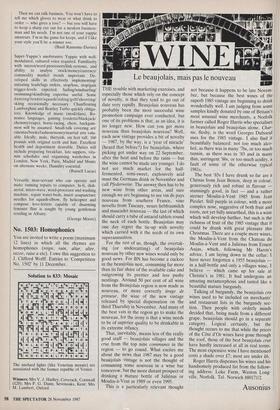Le beaujolais, mais pas le nouveau
THE trouble with marketing exercises, and especially those which rely on the concept of novelty, is that they tend to go out of date very rapidly. Beaujolais nouveau has probably been the most successful wine promotion campaign ever conducted, but one of its problems is that, as an idea, it is no longer new. How can you get more nouveau than beaujolais nouveau? Well, each new vintage provides a bit of novelty — 1987, by the way, is a 'year of miracle' (heard that before?) for beaujolais, where picking got under way on 22 September, after the heat and before the rains — but the wine cannot be made any younger. I do not see much market for the half- fermented, semi-sweet, explosively acid must the Germans drink in November and call Pfederweise. The answer, then has to be new wine from other areas, and sure enough we are beginning to see yin de pays nouveau from southern France, vino novello from Tuscany, neues liebfraumilch and muscadet nouveau — the last of which should carry a tube of antacid tablets round the neck of each bottle. Beaujolais may one day regret the tie-up with novelty which carried with it the seeds of its own superannuation. For the rest of us, though, the overtak- ing (or undercutting) of beaujolais nouveau by other new wines would only be good news. For BN has become a cuckoo in the beaujolais nest, consuming far more than its fair share of the available cake and outgrowing its prettier and less pushy nestlings. Around 50 per cent of all wine from the Beaujolais region is now made as nouveau, or more correctly tirage de primeur, the wine of the new vintage released by special dispensation on the third Thursday in November. And many of the best vats in the region go to make the nouveau, for the irony is that a wine needs to be of superior quality to be drinkable in its extreme infancy. That, inevitably, means less of the really good stuff — beaujolais villages and the crus from the top nine communes in the region — to go round. What excites me about the news that 1987 may be a good beaujolais vintage is not the thought of consuming some nouveau in a wine bar tomorrow, but the more distant prospect of drinking a mature bottle of Julienas or Moulin-A-Vent in 1989 or even 1995.
This is a particularly relevant thought not because it happens to be late Novem- ber, but because the best wines of the superb 1985 vintage are beginning to drink wonderfully well. I am judging from some samples kindly donated by one of Britain's most unusual wine merchants, a Norfolk farmer called Roger Harris who specialises in beaujolais and beaujolais alone. Char- nu, fleshy, is the word Georges Duboeuf uses for the 1985 vintage. I also find it beautifully balanced: not too much alco- hol, as there was in many '76s, or too much tannin, as there was in '83 and in many thin, astringent '86s, or too much acidity, a fault of some of the otherwise typical 1981s.
The best '85s I have drunk so far are a Chenas from Jean Benon, deep in colour, generously rich and robust in flavour — stunningly good, in fact — and a rather sterner Moulin-A-Vent 1985 from Jean Picolet. Still purple in colour, with a more complex nose, suggestive of both fruit and roots, not yet fully unearthed, this is a wine which will develop further, but such is the richness of fruit of the 1985 vintage that it could be drunk with great pleasure this Christmas. There are a couple more wines, the Moulin-A-Vent from the Chateau du Moulin-A-Vent and a Julienas from Ernest Aujas, which, following Mr Harris's advice, I am laying down in the cellar. I have never forgotten a 1955 beaujolais — in a half-bottle and only a villages wine, I believe — which came up for sale at Christie's in 1981. It had undergone an amazing metamorphosis and tasted like a beautiful mature burgundy. Talking of burgundy, the beaujolais cru wines used to be included on merchants' and restaurant lists in the burgundy sec- tion. Then people with orderly minds decided that, being made from a different grape, beaujolais should go in a separate category. Logical certainly, but the thought occurs to me that while the prices of the Cote d'Or wines have gone through the roof, those of the best beaujolais crus have hardly increased at all in real terms. The most expensive wine I have mentioned costs a shade over £7; most are under £6. Roger Harris dispenses his wines and his handsomely produced list from the follow- ing address: Loke Farm, Weston Long- ville , Norfolk. Tel. Norwich 880171/2.
Ausonius


































































 Previous page
Previous page